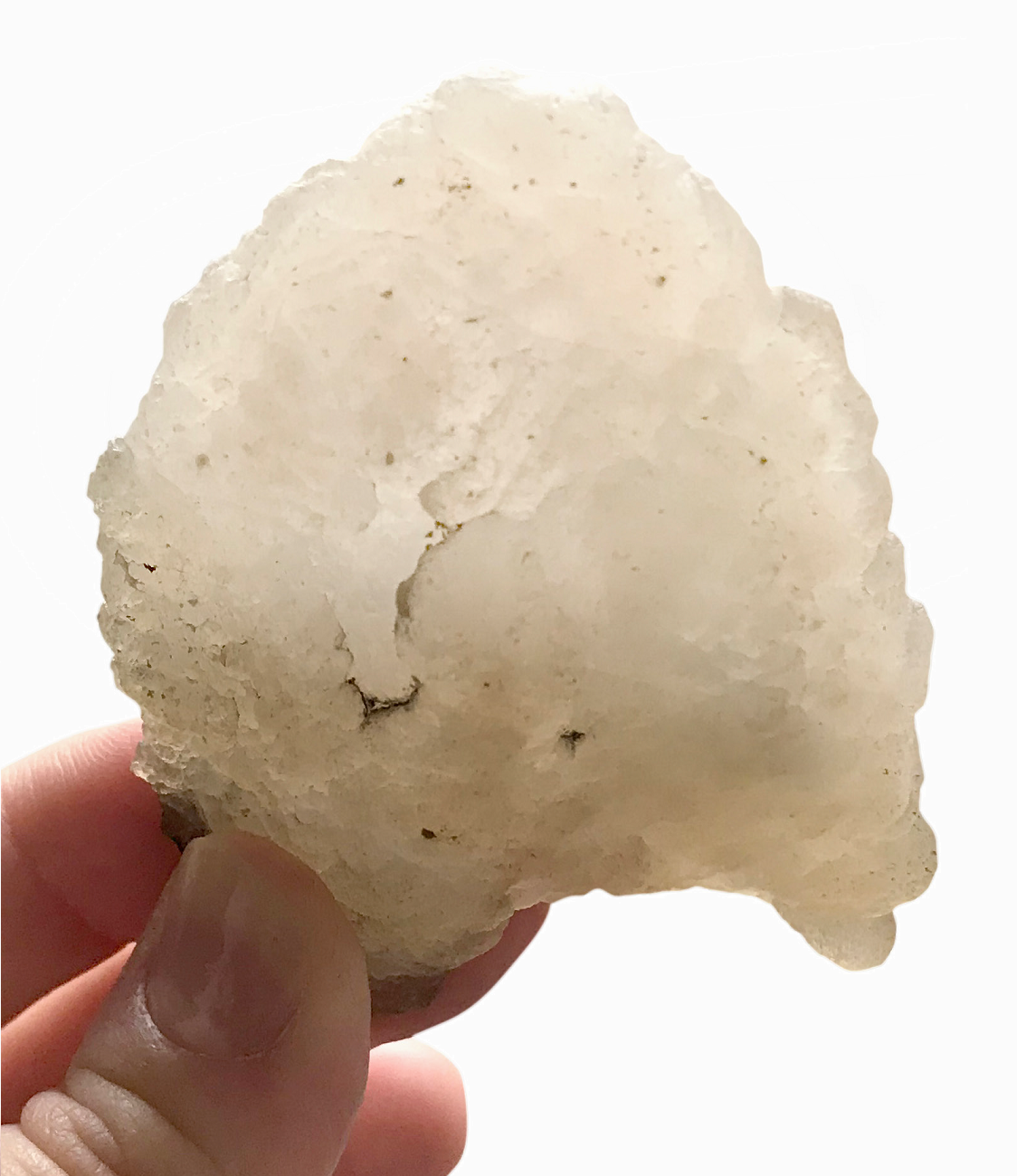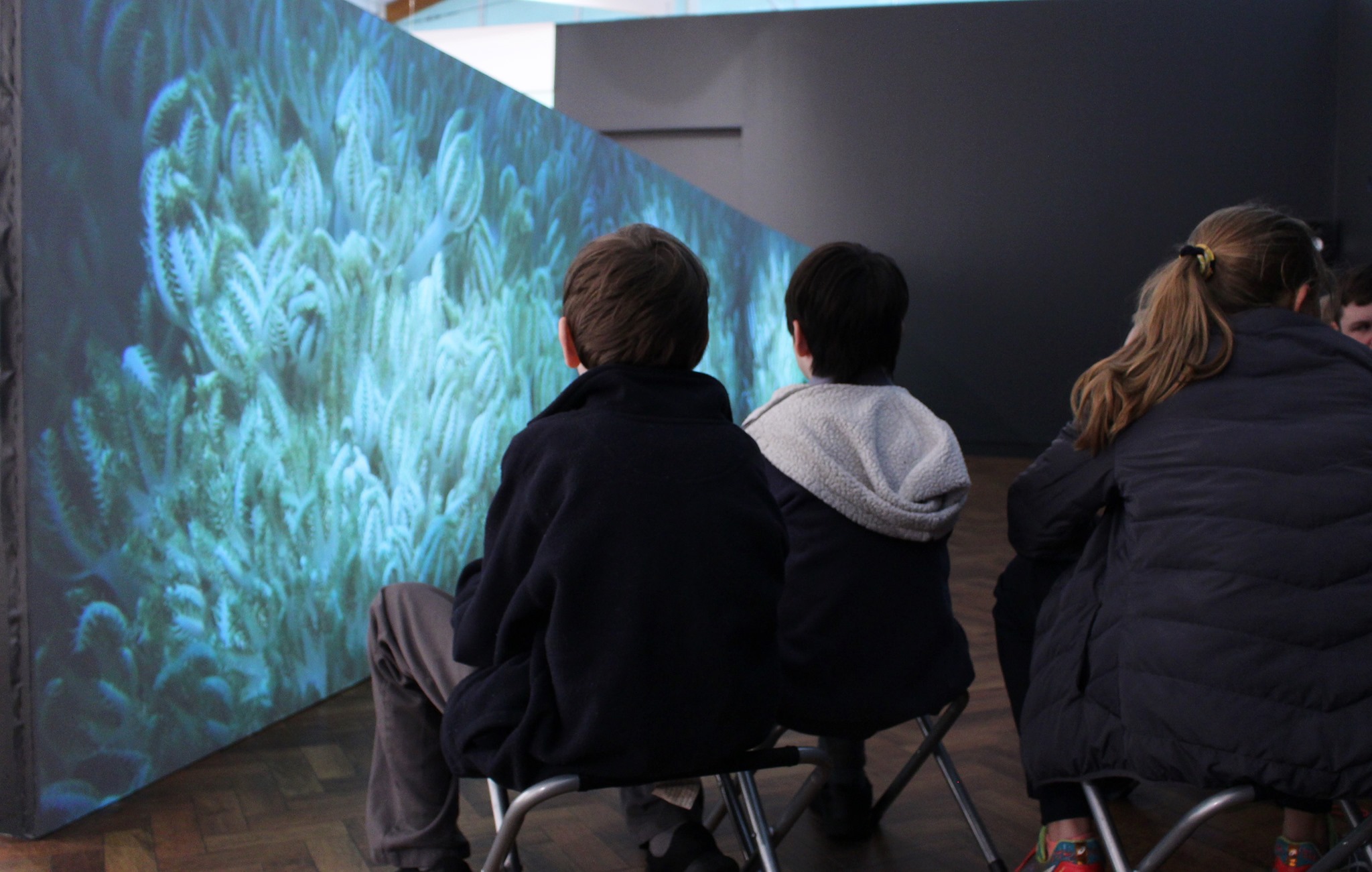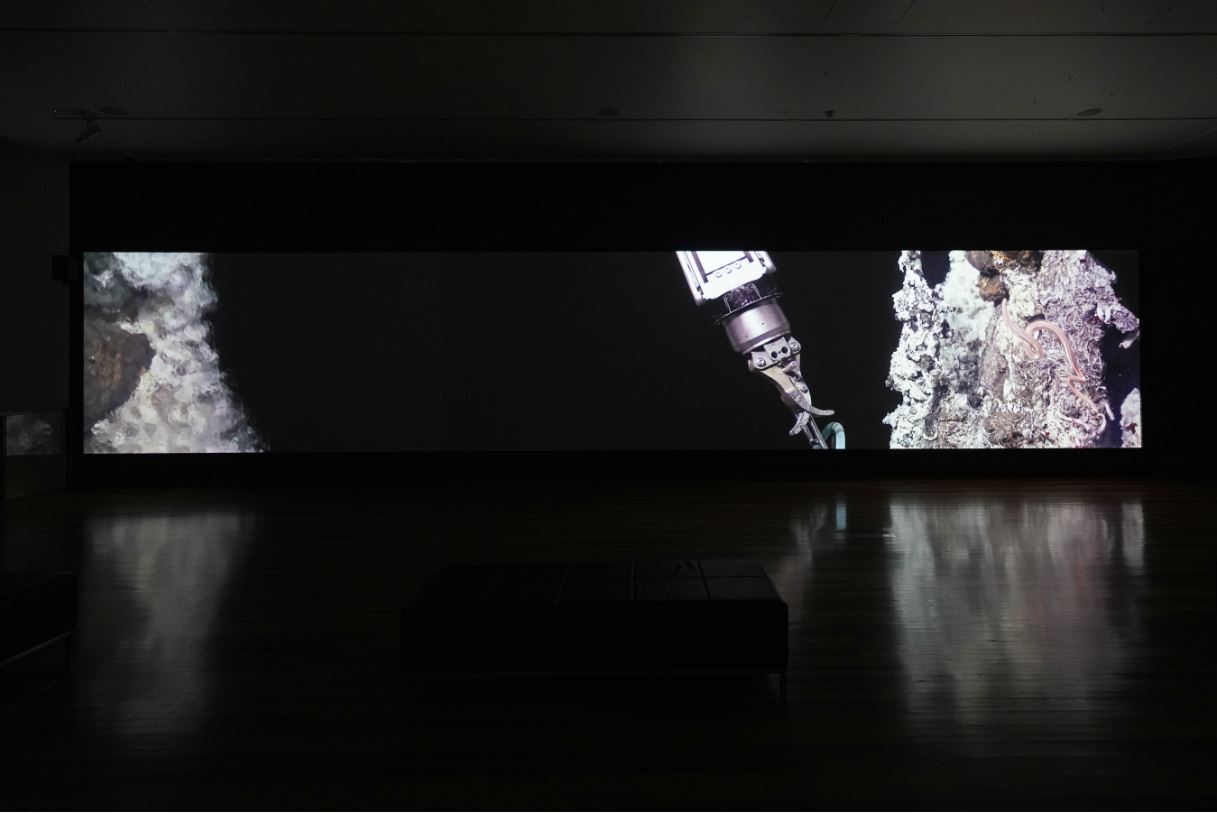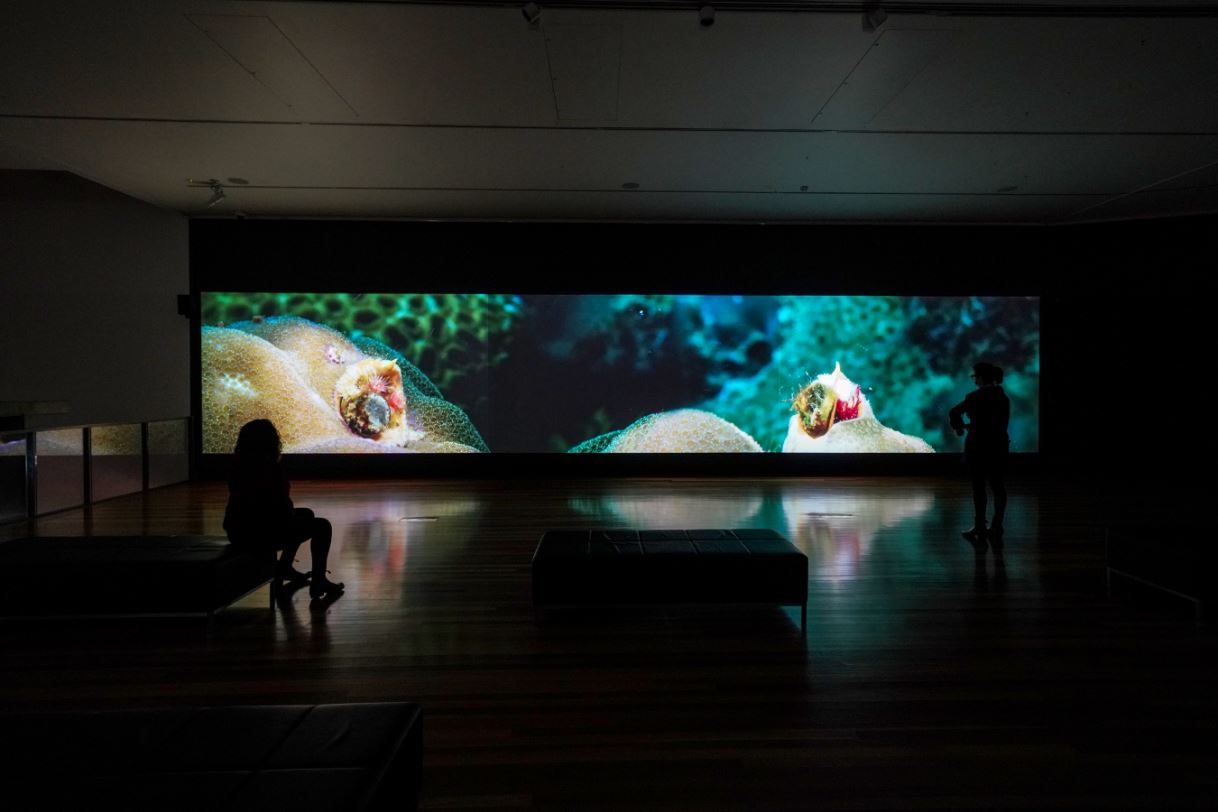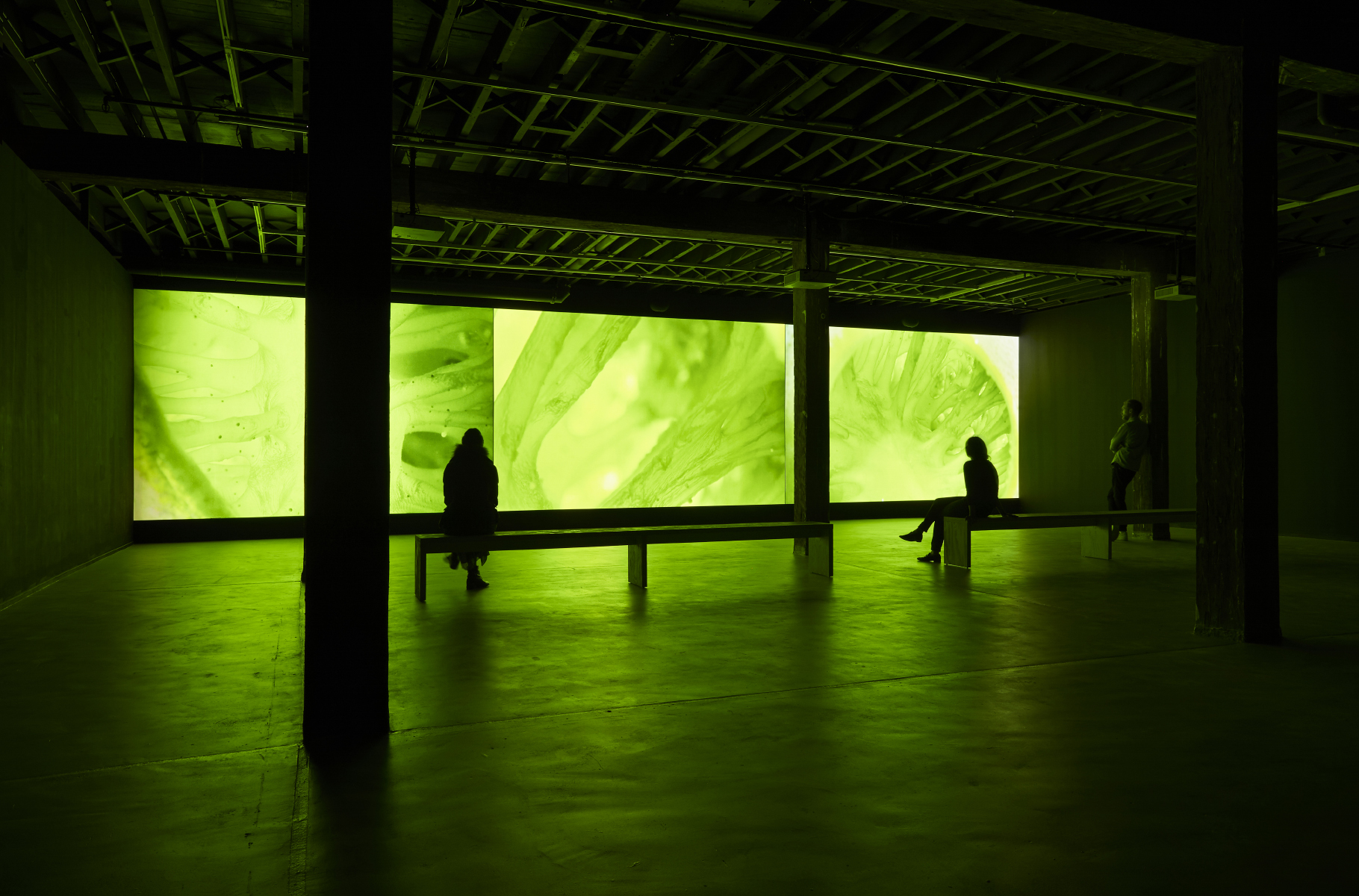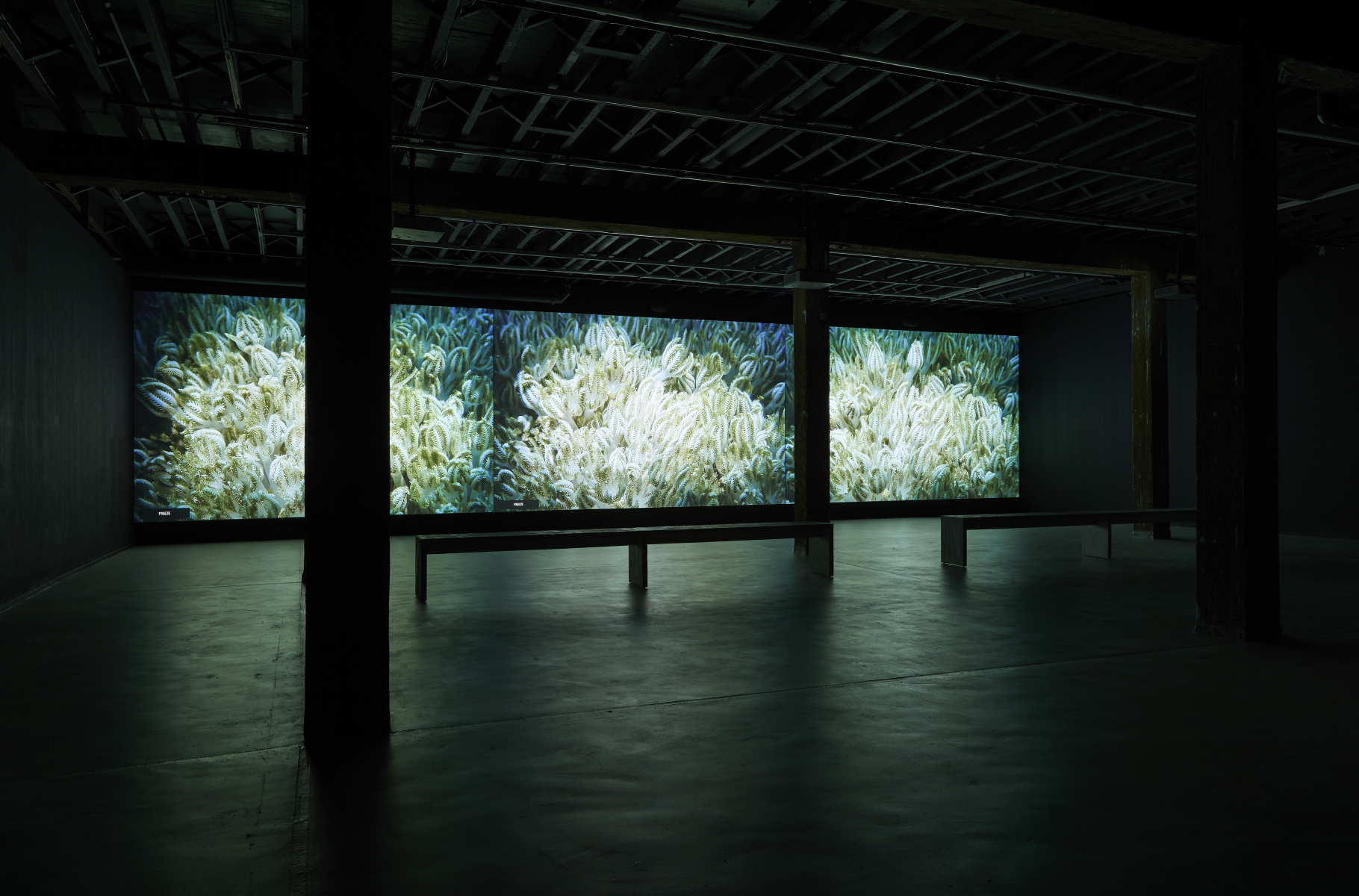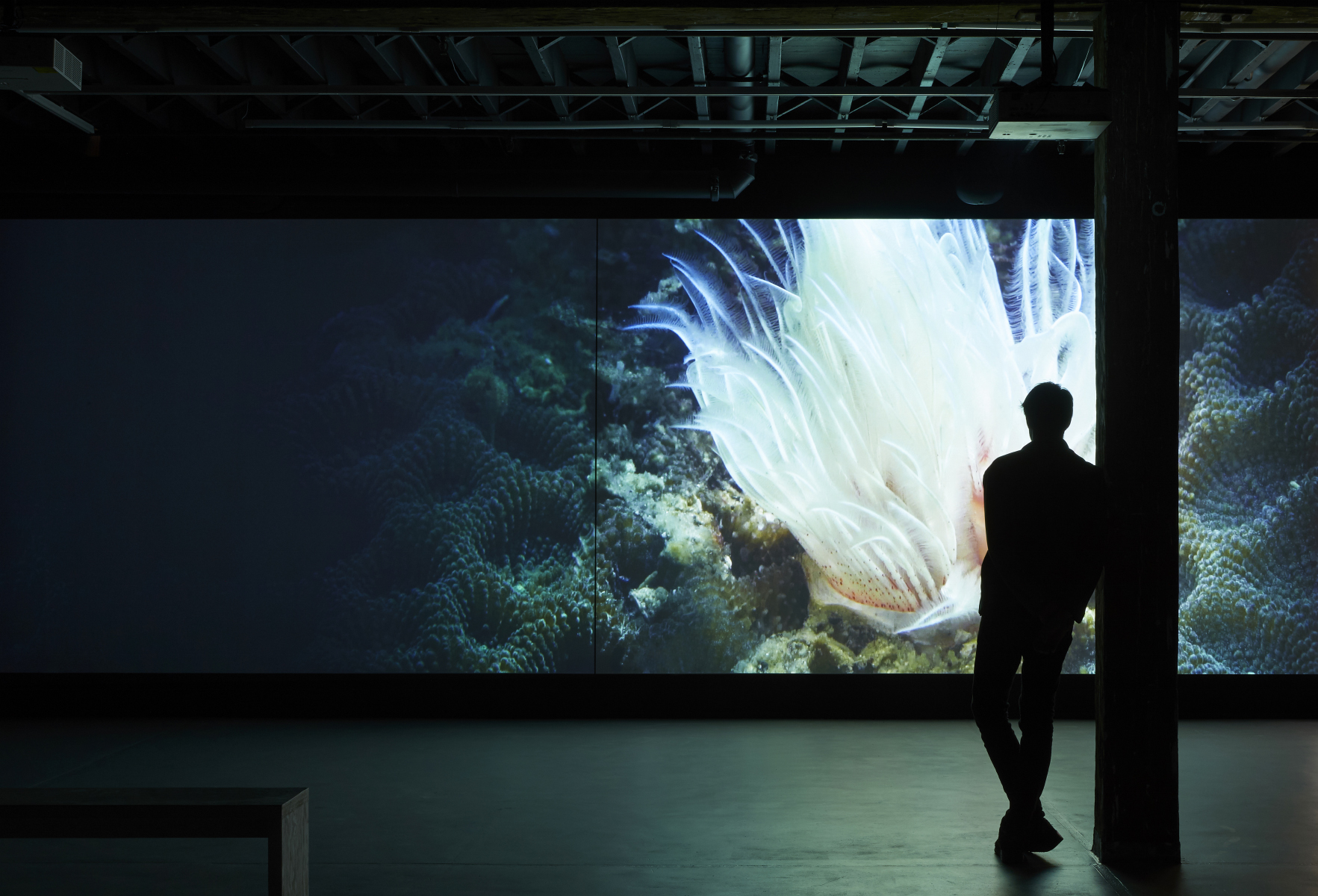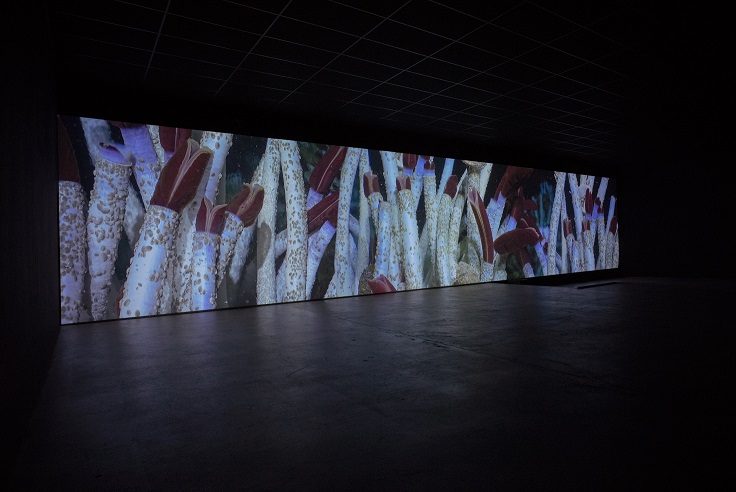Centre of the Centre | Video Artwork
A mineral containing a pocket of primordial liquid given to Mel O’Callaghan by her grandfather, the mineralogist Albert Chapman, was the impetus for Centre of the Centre. The artist explains that this type of mineral is created when hot gasses meet cold water, creating cavities in the molten magma in volcanic rock. The potentiality of this liquid and the extreme hot-cold geophysical conditions that formed this mineral led Mel O’Callaghan 4km down in the Pacific Ocean and in the Verde Island Passage in the Philippines. During a three-week mission in the Pacific, O’Callaghan filmed hydrothermal vents in the depths of the ocean using the deep-ocean research submersible Alvin with the support of the Woods Hole Oceanographic Institution. In this cinematic video artwork, O’Callaghan allows audiences to observe the lifeforms that endure and prosper within environmental super-pressures and exist in total darkness. She does so by bringing to light, and to the surface, scenes of enigmatic plant and animal life in full, vibrant colour that has been finely tuned by an expert colourist. The beauty and rhythmic motion of these lifeforms are enhanced via a soundtrack incorporating breathing sounds and a resonant harp, allowing for a fully immersive experience.
Centre of the Centre
2019
three-channel HD colour video, 48:9, with 5.1 surround sound
20 minutes
This video captures hydrothermal geological formations on the sea floor and ‘extremophiles’ – psychedelic organic life found at mid-ocean ridge hydrothermal vents and volcanic seamounts. During a three-week expedition in the eastern Pacific on the research ship Atlantis, the submersible Alvin was deployed eight times to depths of 2500 metres. Alvin was equipped with highly specialised deep-sea still and video cameras, operated by the team of pilots and scientists with direction from the artist. The film was produced in close collaboration with marine geologist and Emeritus Research Scholar Dr. Daniel Fornari, with the support of the Woods Hole Oceanographic Institution and the US National Science Foundation.
The video descends to the East Pacific Rise axis, nearly 2.5 km beneath the ocean surface to deep-sea hydrothermal vent fields and off-axis seamounts (at 9° 50’N and approx. 8° 20’N, respectively). The vents are formed through complex thermal and chemical interactions between magma in the ocean crust and circulating seawater. The geological formation of the vent chimneys, the geochemical exchanges and the micro/macro biota living in the vent environments co-evolve. They exist in an environment devoid of light, at extreme temperatures (350-410°C) and high pressure.
At the threshold between boiling and freezing, a shimmering hydrothermal fluid – a mixture suspended between water, gases and minerals – surrounds the vents. The Alvinella worm seen in the film has fully adapted to this threshold, thriving in divergent temperatures simultaneously. Cross-sections of basalt lava rocks are magnified and polarised. The photomicrographs of these lava rocks collected during the mission are set in motion as blueprints of the Earth, creating itself from the core – from the centre – outwards.
From these depths, the video transitions to a second location: the coral outcrops of the Verde Island Passage in the Philippines, a site declared the ‘Centre of the Centre of Marine Biodiversity’ by microbiologists at the California Academy of Sciences in 2006. The two sites captured in the film – the depths and the shallows – are potentially the point of origin of all life on Earth and the epicentre of its marine regeneration. Despite the extremes of the
environments of these life forms, the film captures phases of genesis and regeneration.
Breathing is a critical motif throughout the exhibition, and an inherently empathetic reflex. The soundtrack to the underwater dives is an ecstatic sonic collage made from recorded sounds of breath and harp. Image and sound act together as a score, triggering altered states of consciousness. The progressively intensive breathing of the different life forms, of the soundtrack and of the audience of the film, together build up to an operatic climax.
Meet the Extremophiles
Outtakes from Mel O’Callaghan’s video work ‘Centre of the Centre’. This series of short vignettes was produced by UQ Art Museum.
An Extremophile is “an organism that thrives in physically (temperature) or geochemically (acidity, alkalinity) extreme conditions, which are detrimental to most life on Earth.” – Dr. Daniel J. Fornari, Woods Hole Oceanographic Institution. The word roughly translates to “extreme love.”
“Extremophiles are microorganisms that live in conditions of extreme temperature, acidity, alkalinity, or chemical concentration – at the hydrothermal vents where gas-rich fluids spew out at over 350 degrees C into near-freezing bottom water. Somehow, I felt like we could all relate to this in a universal way, as we are increasingly challenged environmentally, politically, and emotionally in these extreme times.” – Mel O’Callaghan
Alvinella Pompeii Worm
The small, red Alvinella Pompeii Worm (or Alvinella Pompejana) are found in the hydrothermal vents almost 2500 metres under the surface of the ocean. These Alvinella were imaged at the Eastern Pacific Rise, a fast-spreading portion of the global midocean ridge system, during a three-week mission in the Pacific, where artist @mel_ocallaghan and Dr. Fornari filmed hydrothermal vents in the depths of the ocean using the submersible Alvin.
Effortlessly moving in and out of freezing temperatures as low as 2-3°C to hotter than 350°C, Dr. Fornari explains that “The Alvinella live with its head in an ice box and backside in the oven.” A stunning feat for any living creature to survive in that temperature range
Gold Worm or Polynoid Scale Worm
The Polynoid Scale Worm shown in the video lived at near freezing temperatures at the
seafloor on a volcanic seamount in the eastern Pacific Ocean.
This creature (which is this luminous colour in real life) along with the extremophiles that live at such depths are so significant to us because, as Dr. Daniel J. Fornari from the Woods Hole Oceanographic Institution explains, ‘The biology and genetics of this group of animals likely holds many keys to better understanding how life evolved on Earth. Perhaps they can give us clues about how we can treat certain diseases, as well as what we might expect to find if we explore for life on other planets and moons in our solar system.’
Tube Worm or Riftia Worm (Riftia pachyptila)
According to Dr. Daniel J. Fornari from the Woods Hole Oceanographic Institution, the vibrant red plumes on Riftia Worms are used for the animal to intake oxygen from seawater into the haemoglobin in its blood.
Pink Worm or Polychaete Worm
The Polychaete Worm is pictured gliding across the depths of the ocean near an active hydrothermal vent chimney, at 2500 metres depth. Its twirling body appears as though it is soaring through the sky, not swimming. Its ethereal presence reinforces the power of these creatures and their capability to thrive in extreme environments.
Mel O’Callaghan on Minerals
Mel O’Callaghan discussing the impetus for Centre of the Centre for the exhibition What Lies Within: Centre of the Centre at the Museum of Contemporary Art and Design (MCAD), Manila
Woods Hole Oceanographic Institution
Woods Hole Oceanographic Institution (WHOI) is the world’s leading, independent non-profit organization dedicated to ocean research, exploration, and education. Our scientists and engineers push the boundaries of knowledge about the ocean to reveal its impacts on our planet and our lives.
Since 1930, WHOI scientists and engineers have laid the groundwork for many of the discoveries that have revolutionized our knowledge about the ocean and its impacts on our planet and our lives. From the discovery of hydrothermal vents to the development of revolutionary ocean technology to mapping global ocean circulation, our research matters now more than ever before.
Illuminating the Abyss | Inspiration, Exploration, and Discovery in the Ocean Twilight Zone
Four leading ocean explorers and advocates come together for a conversation about pushing boundaries and seeking solutions to the Earth’s most pressing problems—deep in the ocean’s twilight zone.
James Cameron – Ocean explorer and Academy Award–winning filmmaker
Ray Dalio – Founder, Dalio Philanthropies and Co-founder, OceanX
Peter de Menocal – President and Director, Woods Hole Oceanographic Institution
Edith Widder – Deep-sea biologist and Founder, CEO, and Senior Scientist of the Ocean Research & Conservation Association
With special guest host, journalist and author Tatiana Schlossberg.
Centre of the Centre video credits
Cinematography
Verde Island Passage: Dennis M. Corpuz
9°50’N East Pacific Rise and 8°20’ N Seamount Chain AT4206 onboard the R/V Atlantis:
Dr Patricia Gregg, Chief Scientist, University of Illinois at Urbana-Champaign
Dr Daniel Fornari, Co-Chief Scientist, Woods Hole Oceanographic Institution
Dr Michael Perfit, Co-Chief Scientist, University of Florida
Dr Ross Parnell-Turner, Co-Chief Scientist, Scripps Inst. of Oceanography
Dr Elizabeth Trembath-Reichert, Co-Chief Scientist, Arizona State University & Woods Hole Oceanographic Institution
Dr Dorsey Wanless, Co-Researcher, Boise State University
Dr Barbara John, Co-Researcher, University of Wyoming
Ken Kostel, Co-Researcher, Woods Hole Oceanographic Institution
Dr Karthik Anantharaman, University Wisconsin-Madison
Dr Rika Anderson, Carleton College
Molly Anderson, Boise State University
Dr Alysia Cox, Montana Tech.
Dr Aida Farough, Kansas State University
Dr Heather Fullerton, College of Charleston
Dr Dalton Hardisty, Michigan State University
Dr Santiago Herrera, Lehigh University
Dr Valentina Romano, University of Illinois at Urbana-Champaign
Dr Matt Smith, University of Florida
Dr Drew Syverson, Yale University
Dr Carolyn Tepolt, Woods Hole Oceanographic Institution
Alvin Pilots:
Danik Forsman
Jefferson Grau
Mike Skowronski
with support from R/V Atlantis officers and crew; Alvin Operations Group; Sentry Operations Group
Video Micrographs: Dr Matthew Smith and Dr Michael Perfit, Department of Geological Sciences, University of Florida with Ethan M. Conrad
Performer: Damaris Haertl
Music: Saori Kikuchi and Pauline Amar
Sound Design: Matthieu Gasnier
Production: Clemens Habicht and Alexandra Pedley
Post-Production: Olivia Hantken, Collider Films, Sydney
Colourist: Matt Fezz
Cameras: DeepSea Power & Light, MISO Facility – WHOI, and Ocean Imaging Systems
Submergence Operator: National Deep Submergence Facility WHOI – Alvin Group
Film and images captured on AT4206 onboard the R/V Atlantis in December 2018: D. Fornari, WHOI/NSF/HOV Alvin, 2018, ©Woods
Hole Oceanographic Institution
Courtesy the artist; Kronenberg Mais Wright, Sydney; Galerie Allen, Paris; and Galerie Belo-Galsterer, Lisbon.
Mel O’Callaghan’s Centre of the Centre was curated and developed by Artspace and is touring nationally with Museums & Galleries of NSW. Centre of the Centre is co-commissioned by Le Confort Moderne, Poitiers; Artspace, Sydney; and The University of Queensland Art Museum, Brisbane. With Commissioning Partners Andrew Cameron AM & Cathy Cameron and Peter Wilson & James Emmett; and Lead Supporter, Kronenberg Mais Wright. The development and presentation of Centre of the Centre is supported by the Fondation des Artistes, Woods Hole Oceanographic Institution, and the US National Science Foundation. This project has been assisted by the Australian Government through the Australia Council for the Arts, its arts funding and advisory body


